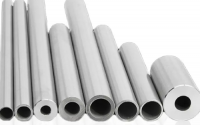What You Should Know About Molybdenum Electrodes
What Are Molybdenum Electrodes?
Molybdenum electrodes are formed by balanced pressing, forging to various of types after sintering with medium frequency furnace and then turning, rolling, planning and milling. It is used as electro-heat equipment of the glass fiber kiln.
The main component of the molybdenum electrode is molybdenum and prepared by powder metallurgy. The internationally used molybdenum electrode contains 99.95% of the components and has a density greater than 10.15g/cm3 to guarantee the quality of the glass and the service life of the electrode. The commonly used molybdenum electrode size ranges from 20mm to 152.4mm in diameter, and the single length can reach up to 1500mm. The current molybdenum electrode can replace the original heavy oil and gas energy, and effectively reduce the pollution to the environment and improve the quality of glass.
Advantages of Molybdenum Electrodes
The material of molybdenum electrode is softer than that of tungsten material and has incomparable elastic modulus. Molybdenum electrode has many excellent properties, such as high melting point, good machining, corrosion resistance, low expansion, ultra-high strength and stiffness, excellent thermal conductivity, good ductility, as well as low emissivity, resistivity, and steam pressure.

According to the advantages of the molybdenum electrode, it can be applied in different fields. Molybdenum electrode is characterized by high hardness, high melting point and superior performance at high temperature, which is suitable for welding non-ferrous metal copper, aluminum, nickel, etc.
The Size of Molybdenum Electrodes
Generally, the diameter of the molybdenum electrode is between 35 ~ 75mm, while the size of the molybdenum electrode is determined by the current density. Normally, the electrode with the diameter of about 50mm is selected for melting borosilicate glass, and the promotion of the electrode in operation depends on the actual current density. For the vertical electrode, the electrode continuation should be considered when the density reaches 0.8A /cm2.
As the electrode consumption increases, the current density of the electro melting furnace with a longer furnace age (more than 4 years) increases. If the electrode is not ready to be continued, the current density needs to be controlled at a lower value. When the current density of the molybdenum electrode runs below 0.6A /cm2, the electrode is barely consumed.
The resistivity of soda lime glass and other low resistance glass is lower than 15Ω·cm, so it is difficult for the electrode to control the current density below 0.6a /c m2. Due to its low viscosity and low resistivity, 75mm electrodes are often used. In addition, the electrode will have different degrees of loss during operation, so the electrode must be carried forward. From the operating cost of the electrode, the plate electrode consumption is less, so it is more suitable for sodium and calcium glass melting.
Factors Affecting the Service Life of Molybdenum Electrodes
The glass industry is a traditional industry with high energy consumption. With the high price of fossil energy and the improvement of environmental protection requirements, melting technology has changed from traditional flame heating technology to electric melting technology. The electrode is the element that contacts directly with the glass liquid and passes the electrical energy to the glass liquid, which is the important equipment in the glass electrofusion.
Molybdenum electrode is an indispensable electrode material in glass electrofusion because of its high-temperature strength, corrosion resistance and the difficulty in making glass coloring. It is hoped that the service life of the electrode will be as long as the kiln age or even more than the age of the kiln, but the electrode will often be damaged during the actual use. It is of great practical significance to fully understand the various influencing factors of the service life of molybdenum electrodes in glass electro-fusion.
- Oxidation of the molybdenum electrode
The molybdenum electrode has the characteristics of high-temperature resistance, but it reacts with oxygen at high temperature. When the temperature reached 400 ℃, the molybdenum will begin to form molybdenum oxidation (MoO) and molybdenum disulfide (MoO2), which can adhere to the surface of molybdenum electrode and the form oxide layer, and organize the further oxidation of molybdenum electrode. When the temperature reaches 500 ℃ ~ 700 ℃, molybdenum will start oxidized to molybdenum trioxide (MoO3). It is a volatile gas, which destroys the protective layer of the original oxide so that the new surface exposed by the molybdenum electrode continues to oxidize to form MoO3. Such repeated oxidation and volatilization makes the molybdenum electrode continuously eroded until it is completely damaged.

- The reaction of the molybdenum electrode to the component in the glass
The molybdenum electrode reacts with some components or impurities in the glass component at high temperature, causing serious erosion of the electrode. For example, the glass solution with As2O3, Sb2O3, and Na2SO4 as the clarifier are very serious for the erosion of the molybdenum electrode, which will be oxidized to MoO and MoS2.
- Electrochemical reaction in glass electrofusion
The electrochemical reaction occurs in the glass electrofusion, which at the contact interface between the molybdenum electrode and the molten glass. In the positive half cycle of the ac power supply, negative oxygen ions are transferred to the positive electrode to release electrons, which release oxygen to cause the oxidation and of the molybdenum electrode. In the ac power supply negative half cycle, some of the glass melt cations (such as boron) will move to the negative electrode and the generation of molybdenum electrodes compounds, which are loose deposit in the electrode surface to damage the electrode.
- Temperature and current density
The erosion rate of molybdenum electrode increases with the increase of temperature. When the glass composition and process temperature are stable, the current density becomes the factor controlling the corrosion rate of the electrode. Although the maximum allowable current density of the molybdenum electrode can reach 2~3A/cm2, the electrode erosion will be increased if the large current is running.
Please visit http://www.samaterials.com for more information.



